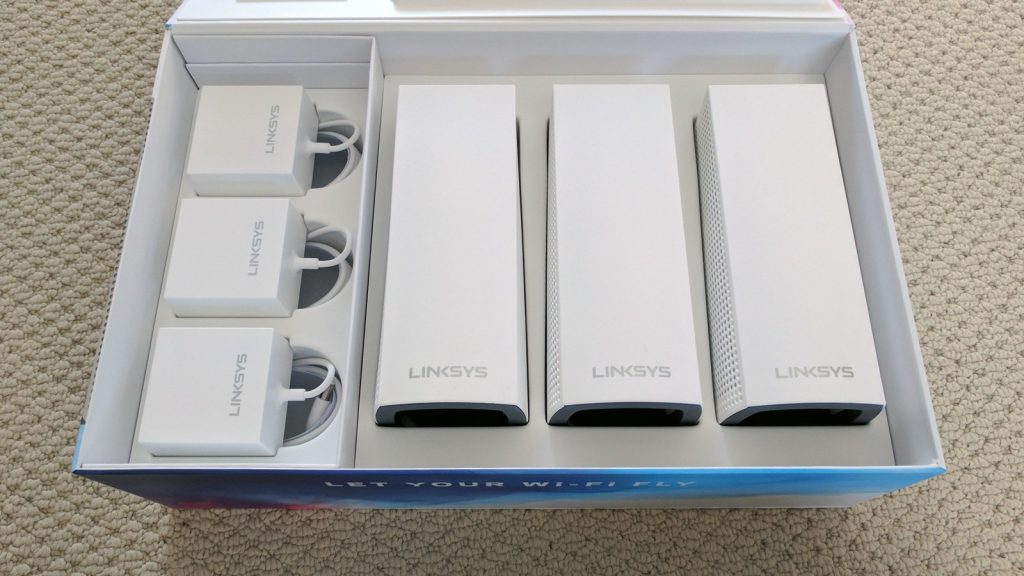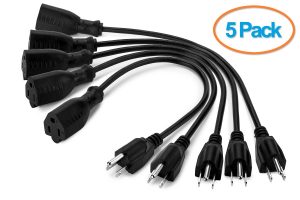We previously looked at the eero Mesh Web system (read our review here). Since then several other manufacturers have entered the field and we recently had a look at the Linksys VELOP Mesh Web system.
Apple Tech Talk Scorecard
| Pros | Cons |
| Easy Set-up | Limited Ethernet Ports |
| Extremely fast Wi-Fi speeds | No USB connectivity |
| Large AC power supplies |
Linksys VELOP Mesh Web System – Unboxing
We have been long time fans of Linksys routers and have previously looked at the WRT1900ACS (read our review here), and the Max-Stream AC1900 (read our review here). We have a long history of using Linksys routers so we were excited to get an opportunity to test out their entry into the mesh web arena.
Upon opening the box, the contents looked more like something from Apple rather than Linksys. We missed not seeing the blue case that became somewhat of a trademark of Linksys products. Fortunately, our disappointment didn’t last long.

In the box are the 3 Linksys VELOP Mesh Web units (referred to as “nodes”), 3 AC power supplies, 1 flat Ethernet cable, a Quick Start Guide and other documentation. (Linksys VELOP is also available in a single or 2 node configuration.)
Also available, though not in the box is a 384 page VELOP User Guide which can be downloaded from the Linksys support site (here). Don’t be overwhelmed by the page count. The User Guide is actually about 35 pages but bundled in a variety of languages.
Each Linksys VELOP node is a tri-band mu-mimo unit and is rated for 400 Mbps on the 2.4 GHz band and 867 Mbps on each of the 5.0 GHz bands. The 2.4 GHz band supports the 802.11B/g/n protocols and the 5 GHz bands support 802.11B/n/ac protocols. The units run on a 716 MHz Quad Core processor and have 4 GB Flash and 512 MB RAM.
Each unit also has 6 antennas with high power amplifiers. On the bottom of each unit are 2 auto-sensing Gigabit Ethernet ports, the AC power connection, a reset button and an On/Off toggle switch. There is a small cut-out on the back edge of the base that acts as a cable retention area for the power cord and Ethernet cable to ensure that the units sit squarely when you place them on a surface.
The units measure 3.1 inches square at the base and stand 7.3 inches tall and weigh a mere 17 oz.
Overall, we like the clean design of the Linksys VELOP units. They have a white plastic exterior with a solid front panel and perforated panels on the other three sides. They are very Apple-like and resemble the now discontinued, but still popular 802.11ac version of the Airport Extreme Base Station (read our review here).
One of the key components of a mesh web system is deploying multiple units around your home. The design of the Linksys VELOP units would easily blend into almost any décor and could easily be mistaken for a piece of modern art. There is a single LED indicator located on the top front corner of the unit and once set-up is complete, has a soft blue color that will hardly be noticed.
Linksys has put together a nice video describing the benefits of the VELOP Mesh Web System.
While overall, we were impressed with the hardware design, we did have a few of complaints.
First, with only two Ethernet ports on the bottom of each node, you have limited ability to make other connections since one port is needed to connect to your modem or existing router. This is not that much of an issue since you could easily add an Ethernet switch like the TP=Link 5-Port Ethernet Desktop Switch (Model # TL-SF1005D), available for only $9.97 from Amazon.
Our bigger disappointment was the lack of a USB connection. Many people are adding a USB hard drive to their router to act as extra or shared storage on their home networks. Some also use the USB port to act as a central printer location of the network. Without a USB port, none of that is possible.
Our final complaint about the hardware is the extremely large power adapters. These may be some of the largest power adapters we have ever seen and doubt there is a conventional power strip that can accommodate it without losing access to at least one other outlet.
If space is an issue, you may want to consider using a short power cord to allow better access to all of your outlets. Consider the Clearmax 1-ft 3-prong power cord set. A package of 5 cords is only $7.99 and is available from Amazon.
Linksys VELOP Mesh Web System – Set-up
Our set-up of the first VELOP node was painless and was handled completely by the free Linksys iPhone app available from the Apple App Store.
With the node connected to power and the app loaded onto our iPhone 7 we were first presented with an option to create an account in the Linksys system. Since we already had one, we just logged in. Next the app asks if you are going to connect your node to a modem or to another router. We appreciated that Linksys already anticipated that many users are provided with a combination modem/router by their ISPs.
We first completed the set-up as a direct connection to our modem. The set-up process was almost completely automated and only took a couple of minutes before it was up and running. We have to say that this was probably one of the easiest router set-ups we ever completed, including for some of the other Linksys routers we have owned or tested.
After the set-up was complete, we intentionally did a factory reset of the node so we could go through the set-up using the option of connecting the node to another router. Except for making that first choice, the set-up was almost identical and equally as painless.
Even performing the factory rest was painless. This is perhaps the first product that did not require us to use our custom built electronics reset tool (it’s actually just a straightened paper clip). To perform the factory reset you simply press and hold the rest button on the bottom of the node. The blue LED on the top turns red and starts to pulse off and on with each pulse being slightly dimmer. You keep holding the reset button until the red LED goes out. That’s it. The node is reset.
At the conclusion of the set-up process, the app asks if you want to add another node to your network. We intentionally said “No” as we wanted to see if the process got any more complicated if you came back at a later time to add another node. It did not. The app has an option to “Set Up a New Product” and prompts you to see if you want to add another node. Once you answer, the app pretty much takes over and repeats the set-up process. The only real difference is that after the set-up, the app tests the placement of the node to ensure that it can communicate well with the first (main) node.
Once everything is set-up, the app provides all of the basic controls you would expect including;
- Confirmation that you are connected to the Internet.
- Provides a list of the devices connected to the VELOP network.
- Allows activation of a Guest Network.
- Allows you to set parental controls on an individual device basis to set a usage schedule and block access to unwanted web sites.
- Set device prioritization in times of heavy network usage
- General VELOP administration.
- Port Forwarding.
- MAC address management.
All of this is laid out nicely in an easy to understand format. Users who need this level of management should have no trouble navigating the app. For those of you that have no idea what any of this means, you can take comfort in knowing that the VELOP mesh web system takes care of almost all of this out of the box and once the system is up and running, you may never need to look at the app again.
Here is a short video provided by Linksys that discussed the set-up process.
Linksys VELOP Mesh Web System – Test Results
The main advantage to a mesh web system is the consistent wireless speed across the entire network. Few if any people using a wired Ethernet system would probably opt for a mesh web system since a more conventional router would serve their needs at a lower price. Because of this, we focused our testing on the wireless performance of the Linksys VELOP Mesh Web System against our exiting wireless network which consists of an Apple Airport Extreme 802.11ac router as our primary unit, with an older Airport Extreme 802.11n and current Airport Express 802.11n acting as extensions of the primary router.
We certainly acknowledge that having two “n” routers on the network will slow things down but we also think this is somewhat of a real world situation since many people choose to repurpose some of their old hardware as the upgrade to newer components.
All of our test were conducted using the Speedtest.net app for the iPhone 7. The Linksys app has a built-in speed test feature but we could not test the Airport network with that and wanted to be sure we eliminated any major differences in our testing.
That said, we can say that we did compare the Linksys app speed test to one run on the Speedtest.net app and the results were almost identical, with the Linksys app reporting only slightly faster speeds, but nothing that would impact our conclusions.
We have found in the past that it is better to use servers that are a distance away to get a more realistic idea of connection speeds. All tests were run using servers that were about 120 miles away from our location. Our internet service is provided by Cox Communications which guarantees download service of 150Mbps.
For our first test we were right next to both the Linksys VELOP and the Airport Extreme 802.11ac and got the following results:
| Airport Extreme | Linksys VELOP | |
| Download | 71.18 Mbps | 164.25 Mbps |
| Upload | 10.76 Mbps | 13.39 Mbps |
Running the same test on our MacBook Pro connected by Wi-Fi to the respective networks turned in similar results.
We had always considered our Internet service to be better than acceptable. With numerous computers, iPhone and iPad devices and a variety of Internet of Things devices, we never experienced issues. Downloads were generally fast and our ability to download and stream videos was always acceptable with no dropouts or buffering. Tasks like upgrading apps and iOS upgrades were always acceptable.
Moving these things to the Linksys VELOP Mesh Web System provided a whole new level of service.
We then moved up to the second floor where we have the Airport Express (n) and a second VELOP node. When we ran the tests again the differences were even more striking.
| Airport Extreme | Linksys VELOP | |
| Download | 49.91 Mbps | 167.84 Mbps |
| Upload | 11.00 Mbps | 12.56 Mbps |
While the download speeds on the Airport Express network dropped by about 30%, the download speed for the Linksys VELOP Mesh Web System stayed virtually the same (it actually increased by about 2%).
We do have to admit that we are not that surprised by these results. The whole basis of a mesh web is that the network speed doesn’t degrade as the signal moves from one node to the next. Linksys has done a great job of managing the hand-off from node to node to ensure that the signal stays as consistent as possible.
Our only service issue was that as various times during our testing, the system would report that our remote node had lost contact with the main node. This seemed to always occur in the early morning hours when there was little to know network activity and by the time we received the notification, the issue seemed to have been resolved.
We also received one notification during our testing period that the VELOP system had lost communication with the Internet. This too seemed to be a very short issue and was almost immediately resolved with no intervention on our part.
The Bottom Line
Mesh web systems are intended for locations that cannot effectively be served by a single router. As such, these multi-device systems tend to be more expensive than many of today’s high speed single router options. However even if you need just a single node to get started, it may be worthwhile to consider a mesh web system if you expect that over time, your network size will grow and you will have a need to expand it with additional nodes.
Overall, we were very impressed with the Linksys VELOP Mesh Web System. Its clean design and ease of set-up make this an easy choice, even if you have no experience in setting up a Wi-Fi network.
The iOS app is well designed and provides all of the important management features you would expect in a modern router.
We do think the minimal number of Ethernet ports is a potential inconvenience but keep in mind, mesh web systems are intended first and foremost as wireless connections and the availability of low cost Ethernet switches can easily resolve this concern.
We do see the complete absence of a USB port a negative and depending on your needs, may make this a non-starter but other than that, it’s hard to find a reason not to give the Linksys VELOP Mesh Web System serious consideration.
The Linksys VELOP Mesh Web system is available in 1, 2 or 3 node configurations from Amazon, or look for them in the router section of the Apple Tech Talk Marketplace.
We wish to thank our friends at Linksys for providing a 3 node VELOP system for our review.
If you liked this article, please consider sharing it with your friends and leaving a comment below.
Also, don’t forget to “Like” us on Facebook, “Follow Us” on Twitter and add the Apple Tech Talk channel to your Apple News app.
Apple Tech Talker



Leave a Comment
You must be logged in to post a comment.